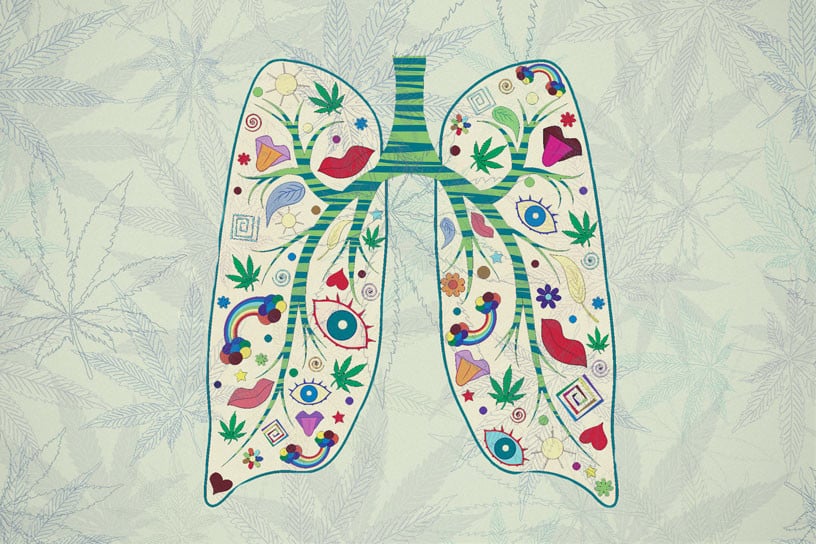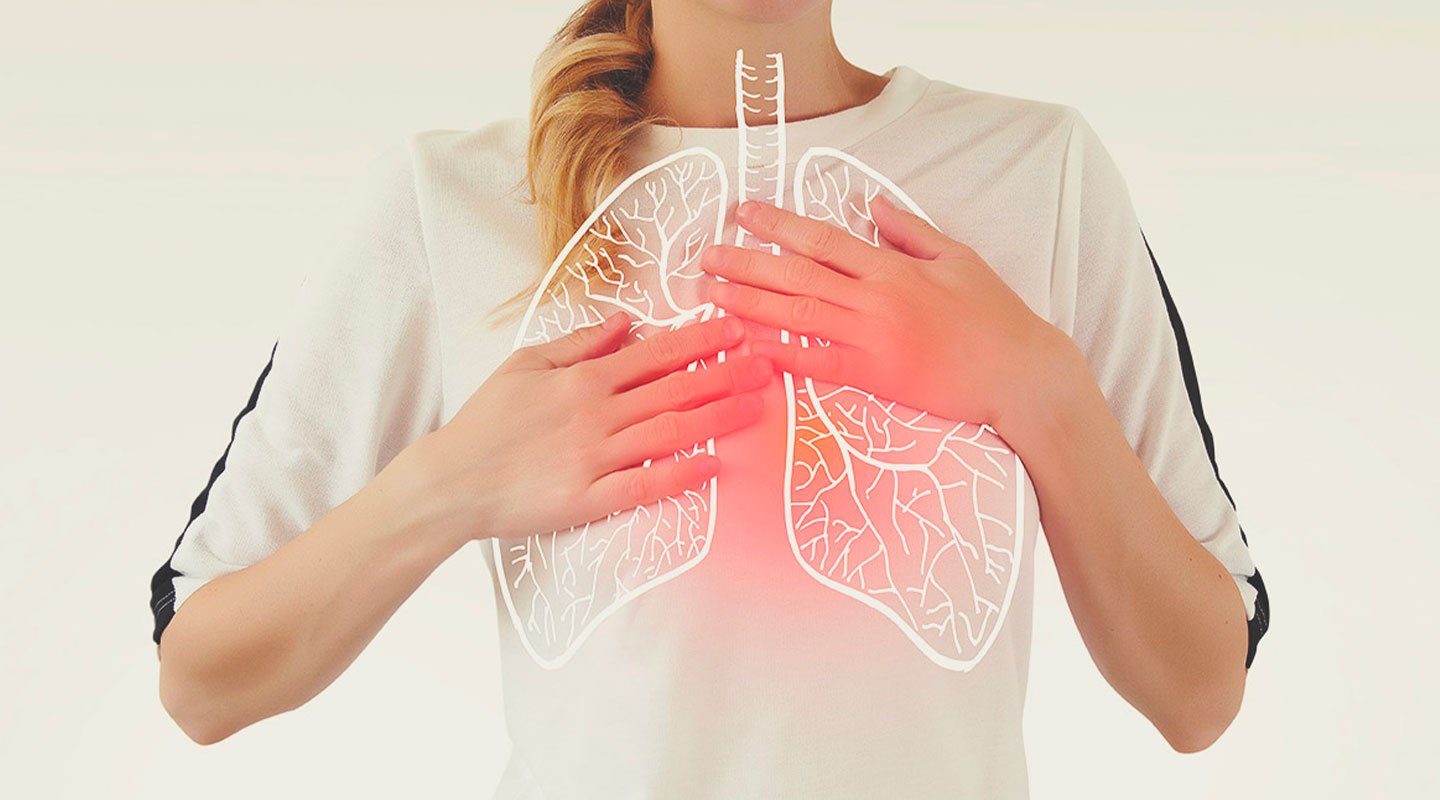.

How Does Cannabis Really Affect the Lungs?
Smoking anything can harm the lungs. But smoking cannabis exposes the lungs to a different set of chemicals than, say, smoking tobacco. Cannabis flowers are loaded with cannabinoids like THC, and these chemicals might change the way carcinogens impact the body. Find out what the research says to make an informed decision on smoking cannabis.
Millions of people smoke cannabis. But at what cost? The truth is, science isn't exactly sure. Some evidence shows smoking weed can harm the lungs, but other studies suggest it might offset the carcinogenic effects of combustion.
Contents:
A Quick Guide to Lung Health
The lungs. You wouldn’t last very long without these trusty biological balloons. Okay, they’re actually much more impressive than balloons. Aside from the fact that they both fill up with air, the comparison ends there. Whereas balloons are hollow and inert, your lungs are alive and filled with a spongy, flexible material that inflates when you inhale. Like most of us, you probably take your lungs for granted. But you’re about to view them from a whole new angle. If you’re high right now, hold on to your hat.
Did you know that your lungs take in around 13 pints of air every minute? Or how about the fact that your lungs, if opened up completely flat (not recommended), would just about cover the surface area of a tennis court? Before you go and share your newfound knowledge with the world, we should probably also inform you how your lungs keep you alive and kicking.
When you inhale, your diaphragm contracts. This dome-like muscle sits under the lungs, creates a vacuum upon activation, and pulls in air. These living bellows are filled with tiny sacs called alveoli that enable oxygen to diffuse into the bloodstream.
Your heart pumps this oxygen-rich blood around your body, delivering key nutrients to your cells to fuel metabolic processes. Your cells produce CO₂ as a waste product, which the blood then carries back to the lungs. As the diaphragm relaxes, we exhale CO₂ out into the atmosphere, and just like that, the breathing cycle completes itself.
If you haven’t figured it out by now, the lungs are pretty important! Therefore, it makes sense to try and keep them as healthy as possible. There are a few things you can do to keep your lung health in check, including:
| Exercising regularly | Avoiding indoor pollutants | Laughing! Seriously, the occasional giggle can help to improve lung capacity | Minimise exposure to air pollution | Don’t smoke |
| Exercising regularly | Avoiding indoor pollutants |
| Laughing! Seriously, the occasional giggle can help to improve lung capacity | Minimise exposure to air pollution |
| Don’t smoke |
If you’re a cannabis smoker (you probably are if you’re reading this article), we didn’t mean to make you drop your joint with that last point. But realistically, you already knew this. Smoking damages the lungs. It’s as simple as that. But what you smoke might actually change how much damage you’re doing.
Marijuana vs Tobacco Smoke
Inhaling smoke of any kind takes a toll on the lungs, whether it comes from weed, tobacco, or a campfire. The combustion of material releases carcinogens and toxins. When you breathe these substances in, you increase the risk of developing respiratory diseases.
But is there a difference between constantly puffing on cigarettes and frequently hitting joints, pipes, and bongs? Before we get into the research that shows how chemicals in cannabis might offset some of the damaging effects of smoking, let’s take a look at how smoking both of these substances exposes the body to dangerous byproducts.


Cigarettes: Carcinogenic Cocktails
It’s no secret that cigarettes are jam-packed with nasty and noxious chemicals. There are over 7,000 chemicals in tobacco smoke[1], and at least 250 of them are known to cause harm. These include:
| Arsenic | Benzene |
Cadmium | Chromium |
Nickel | Formaldehyde |
| Arsenic | Benzene |
| Cadmium | Chromium |
| Nickel | Formaldehyde |
Frequent exposure to these harms almost every organ in the body, leading to oxidative stress, inflammation, and DNA damage that manifests as a long list of diseases, such as:
| Many types of cancer | Heart disease |
Aneurysm | Chronic obstructive pulmonary disease (COPD) |
Diabetes | Arthritis |
| Many types of cancer | Heart disease |
| Aneurysm | Chronic obstructive pulmonary disease (COPD) |
| Diabetes | Arthritis |
Despite these damaging outcomes, millions of people around the world still smoke. Nicotine, the active constituent of tobacco, gets people hooked. This alkaloid is both mentally and physically addictive. As well as constantly craving the physiological effects, people also become attached to the action and ritual of using the drug. The result? Over 8 million deaths every year across the world.
Cannabis Smoke: Different, Not Better
Many cannabis zealots entirely reject the idea of cannabis possibly damaging human health. They come armed with heavy-hitting arguments such as, “But it’s, like, all-natural, man”. But these views often stem from ideological fantasy, not scientific scrutiny. The truth is, smoking cannabis also exposes the body to dangerous chemicals. Here are some facts that most marijuana smokers don’t like hearing:
| Marijuana smokers | Tend to inhale more deeply than tobacco smokers, exposing the former to greater levels of tar. |
| Cannabis smoke | Is linked to chronic bronchitis and damages the cell linings of the airways. |
| Smoking weed |
May increase the risk of air pockets forming between the lungs and the chest wall. |
| Poorly grown and cured cannabis |
Can expose the lungs to fungi, such as Aspergillus. |
| Cannabis smoke |
Contains higher levels of certain carcinogens than tobacco smoke, including 50% more benzopyrene and 75% more benzanthracene. |
| Marijuana smokers |
|
Tend to inhale more deeply than tobacco smokers, exposing the former to greater levels of tar. |
| Cannabis smoke |
|
Is linked to chronic bronchitis and damages the cell linings of the airways. |
| Smoking weed |
|
May increase the risk of air pockets forming between the lungs and the chest wall. |
| Poorly grown and cured cannabis |
|
Can expose the lungs to fungi, such as Aspergillus. |
| Cannabis smoke |
|
Contains higher levels of certain carcinogens than tobacco smoke, including 50% more benzopyrene and 75% more benzanthracene. |
Despite these obvious risks, research has revealed that cannabis smoke might present less of a danger than tobacco smoke. Why? The answer lies in the unique chemicals found in cannabis flowers.
What Does the Research Say About Marijuana Smoke?
Carcinogens aside, the contents of tobacco and cannabis smoke are very different. Whereas tobacco delivers nicotine, marijuana offers a diverse array of phytochemicals, including cannabinoids and terpenes.
Cannabinoids: Protective Against Carcinogens?
When people smoke cannabis, they usually do so with two constituents in mind: THC and CBD. Both of these cannabinoids offer desirable effects. THC gets you high, whereas CBD exerts no psychotropic effects (it doesn’t bind to the CB1 receptor). But these molecules, along with their other cannabinoid counterparts, might just impart some degree of protection against the damaging effects of smoking.
A paper penned by researcher and cannabis advocate Robert Melamede, entitled “Cannabis and tobacco smoke are not equally carcinogenic”, delves into these mechanisms[2]. Melamede states that smoke from both sources contains many of the same damaging substances, including pro-carcinogens called polycyclic aromatic hydrocarbons. Enzymes in the body convert them into actual carcinogens, but THC appears to block this process, leading Melamede to suggest that the cannabinoid offers a protective effect.
Another paper, published in the journal Cannabis and Cannabinoid Research, set out to evaluate the association between smoking cannabis and cancer[3]. The team devised three hypotheses before conducting the research.
First, they noted the possibility that the carcinogenic effects of smoking cannabis would increase the risk of cancer. Second, they predicted that cannabinoids and other phytochemicals might offset these damaging effects. Finally, they hypothesised that the effects of cannabinoids would actually decrease cancer risk.
After analysing a large collection of data, the authors concluded, “The hypothesis that cannabis use increases cancer risk is not supported by the available data. The data instead showed a trend toward a negative association between cannabis use and cancer risk”.


Cannabis and Lung Function
Further research published in 2012 set out to explore the association between cannabis exposure and lung function[4]. The study measured specific parameters in both tobacco and cannabis users, including airflow rate (the speed that a person manages to exhale air) and lung volume (the amount of air a person can hold in their lungs).
The researchers found a strong correlation between tobacco use and reduced lung function. Stefan Kertesz, one of the authors of the study, stated, “There’s a straight-line relationship: the more you use, the more you lose”. The results showed a different trend between cannabis use and lung health. Airflow increased as cannabis users smoked more, up to a certain extent.
However, the researchers point toward frequency as a possible explanation. Whereas tobacco smokers in the study smoked around 20 cigarettes each day, the cannabis users smoked 2–3 times per month on average. However, cannabis inflicted a negative effect on lung function in users that smoked much more heavily.
What About Heavy Marijuana Use?
It appeared that the cannabis users could get away with maintaining lung function when they used the herb occasionally. But users that smoked cannabis frequently and over many years began to experience a decline in lung function, prompting the researchers to call for caution and moderation when smoking marijuana.
What Are the Alternatives to Smoking Marijuana?
Although some of the research above points toward a potential protective effect of cannabinoids, the risk of respiratory illness from smoking cannabis is still very real. But smoking serves as only one intake option for people that use cannabis. Check out two viable alternatives below.
-
Vaping
Vaping cannabis exposes buds and concentrates to much lower temperatures. Instead of combusting plant material, these devices heat cannabinoids, terpenes, and other phytochemicals to their boiling points—releasing them in the form of vapor. However, although vaping poses less of a risk than smoking, it may still negatively impact the heart and lungs.


-
Edibles
Edibles completely remove the lungs from the picture. Instead, these products send THC and other cannabinoids through the digestive tract for processing in the liver before they enter the brain. For this reason, edibles take longer to take in, but the effects last much longer.
Should You Be Worried About Smoking Weed?
Spending your life worrying about every choice you make will only subtract from the amount of joy you get from things. You only live once. If you get true pleasure from smoking cannabis and find it helps you in other areas, then go for it.
But make an informed choice. Living once means you might also want to extend your time here for as long as possible. Smoking cannabis exposes the body to harmful chemicals and increases the risk of developing some diseases. If you want to minimise your risk, try vaping your buds or baking some infused cakes instead.
- Harms of Cigarette Smoking and Health Benefits of Quitting - National Cancer Institute https://www.cancer.gov
- Cannabis and tobacco smoke are not equally carcinogenic | Harm Reduction Journal | Full Text https://harmreductionjournal.biomedcentral.com
- Scoping Review and Meta-Analysis Suggests that Cannabis Use May Reduce Cancer Risk in the United States https://www.liebertpub.com
- Association Between Marijuana Exposure and Pulmonary Function Over 20 Years | Adolescent Medicine | JAMA | JAMA Network https://jamanetwork.com




































